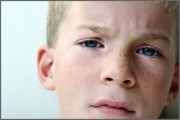Treatment that combines a certain type of psychotherapy, developed by a Temple University psychologist, with an antidepressant medication is most likely to help children with anxiety disorders, but each of the treatments alone are also effective, according to a new study published online Oct. 30, 2008, in the New England Journal of Medicine.
The Child/Adolescent Anxiety Multimodal Study (CAMS) randomly assigned 488 children ages 7 years to 17 years to one of four treatment options for a 12-week period:
- Cognitive behavioral therapy (CBT), a specific type of therapy that, for this study, taught children about anxiety and helped them face and master their fears by guiding them through structured tasks;
- The antidepressant sertraline (Zoloft), a selective serotonin reuptake inhibitor (SSRI);
- CBT combined with sertraline;
- Pill placebo (sugar pill).
The children, recruited from six regionally dispersed sites throughout the United States, including one at Temple University, all had moderate to severe separation anxiety disorder, generalized anxiety disorder or social phobia. Many also had coexisting disorders, including other anxiety disorders, attention deficit hyperactivity disorder, and behavior problems.
“A lot of people trivialize anxiety as inconsequential, thinking that everyone is afraid of a dog as a kid or can anxious about school, but that you grow out of it,” said Philip C. Kendall, professor of psychology at Temple University and senior investigator of the study. “Those anxieties that you mature out of are the normal, trivial ones. However, kids can have some really interfering and maladaptive anxiety that persists over time and, if left untreated, can lead to adult anxiety disorders and other disorders such as depression and substance abuse.”
The study’s lead author, John Walkup of Johns Hopkins Medical Institutions, and his colleagues found that among those in combination treatment, 81 percent improved. Sixty percent in the CBT-only group improved, and 55 percent in the sertraline-only group improved. Among those on placebo, 24 percent improved. A second phase of the study will monitor the children for an additional six months.
“CAMS clearly showed that combination treatment is the most effective for these children. But sertraline alone or CBT alone showed a good response rate as well. This suggests that clinicians and families have three good options to consider for young people with anxiety disorders, depending on treatment availability and costs,” said Walkup.
Results also showed that the treatments were safe. Children taking sertraline alone showed no more side effects than the children taking the placebo and few children discontinued the trial due to side effects. In addition, no child attempted suicide, a rare side effect sometimes associated with antidepressant medications in children.
CAMS findings echo previous studies in which CBT and in which sertraline and other SSRIs were found to be effective in treating childhood anxiety disorder. The study’s results also add more evidence that high-quality CBT, with or without medication, can effectively treat anxiety disorders in children, according to the researchers.
Kendall, who is also director of Temple’s Child Anxiety Clinic, began developing CBT back in 1985. “We developed an organized and comprehensive treatment and have done about 20 years of research and evaluation that found that this was a potentially good treatment,” he said. “So when the six different universities began collaborating about eight years ago on this CAMS study, they decided our treatment was the one we should compare to medication.”
With 488 kids, Kendall said the study, which is one of the largest and most comprehensive child outcome evaluations ever conducted, may help researchers and clinicians better target specific treatments for specific kids.
“Further analyses of the CAMS data may help us predict who is most likely to respond to which treatment, and develop more personalized treatment approaches for children with anxiety disorders,” concluded Kendall. “But in the meantime, we can be assured that we already have good treatments at our disposal.”
The study, which is also being presented at the 55th national meeting of the American Academy of Child and Adolescent Psychiatry, was funded by the National Institute’s of Health’s National Institute of Mental Health (NIMH).
Source: Temple University

